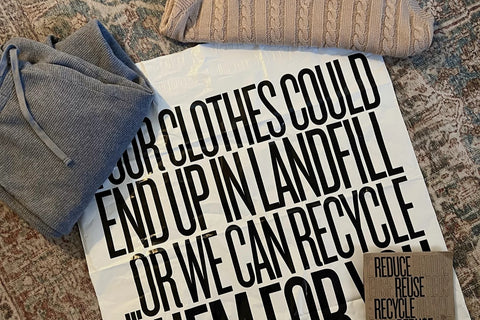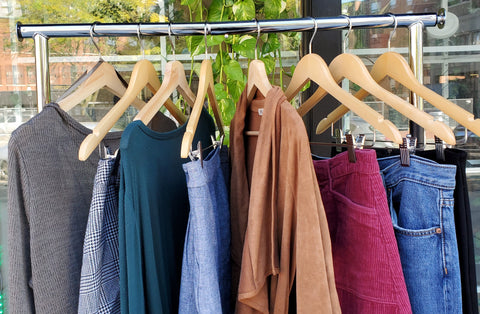You've probably heard some talk about fast fashion and textile waste. But how does someone "waste" clothes? And what can we do about it?
What is clothing waste?
First, we should probably define what clothing waste means. It's any item of clothing (shirts, shoes, underwear, etc.) that goes to a landfill or incinerator instead of being reworn, repaired, or repurposed into something new. A lot of this waste is due to garment overproduction, fast-moving fashion trends, or just bad clothing quality. Fast fashion retailers are one of the major contributors to clothing waste, producing clothes quickly and in large quantities with the goal of selling as much as possible to as many people as possible. However, this often leads lots of unsold clothes that are simply thrown away. Even the clothes that are sold oftentimes end up in the trash pretty soon anyways, whether because they fall apart after a couple uses or they're replaced by ever-changing trends.

Credit: The Nix Company/Unsplash
Why does it matter?
It’s no surprise that this kind of overproduction has a significant impact on the environment. When discarded clothing is buried in landfills or burned in incinerators, all the resources and greenhouse gas emissions that went into making them are going to waste. Not only that, since the fashion industry profits by making clothes in the least expensive and fastest ways possible, they rely on cheaper synthetic materials that contain plastics (like polyester, nylon, acrylic, and more) to make them. These kinds of materials use huge swaths of resources, are not biodegradable, and release microplastics as they slowly break down over hundreds of years.
What can we do about it?
Luckily for those of us living in Massachusetts, we don't have to tackle clothing waste on our own! In 2021, Massachusetts updated their Solid Waste Master Plan to add textiles and mattresses to the list of materials banned from disposal. While it's not a cure to the textile waste problem, it's an important step towards more widespread zero waste practices. Even if your state doesn't have a disposal ban in place, there are other small ways we can reduce clothing waste in our own lives.
A rack of second-hand clothes hanging outside of Uvida Shop during one of our seasonal clothing swaps.
Reduce first:
- If you have the means, one of the best things you can do is try to buy fewer and better quality garments. They may cost more upfront, but you won’t have to replace or repair them nearly as often.
- You can also repair or upcycle older or damaged clothing. Turn an old shirt or pair of jeans into a tote bag, or get them professionally repaired at your local tailor! You can even try your hand at patching up smaller repairs.
Then reuse:
- Clothing swaps, like the ones we hold seasonally at Uvida, are a great way to get new use out of your old clothes! By giving people a space to exchange used clothes right in their city, our swaps make sure hundreds of clothing items go to new homes instead of the landfill. You never know if you'll find your new favorite top or sweater! Stop by our clothing swap or even host one with your friends to exchange your preloved clothes instead of buying new.
- Donate or sell your clothes! There are plenty of ways you can donate your garments: through thrift stores, non-profits, or even to your friends! There are even some online marketplaces to help you sell your preloved clothes.
- Shop secondhand! You can shop at local thrift stores or flea markets for second-hand clothes to avoid purchasing directly from fast-fashion retailers.
Finally, recycle:
- If none of the above options are available to you, there are some groups that are changing how we recycle textiles. You can use resources like Recycle Smart to find textile recycling drop offs near you. The Take Back Bag program is another great option.

The 'Take Back Bag' clothing recycling program. Credit: Popsugar.
How do you fight clothing waste?
Change doesn't happen in a bubble, so we need you to help us continue the conversation! Share your favorite ways to reduce clothing waste (whether it’s shopping second hand, donating, or upcycling) in the comments, and get your friends and family involved the next time you're sorting through your closet or headed to your favorite vintage store.
If you’re looking for another way to reduce waste, join us at our next seasonal clothing swap! We offer them four times each year (winter swap in January, spring swap in April, summer swap in July, and fall swap in October) so you have plenty of opportunities to exchange clothes and connect with the Boston zero waste community. Just bring in any clothes you don't want anymore, don't fit, or just aren't your style anymore and you can swap them 1-to-1 for anything else someone's brought in! We accept all clothing styles, types, & sizes including shoes and bags -- we just ask that you wash everything before you drop it off. Make sure to subscribe to our newsletter (bottom of this page) and follow us on Instagram to receive the latest updates on upcoming events like our clothing swap!


